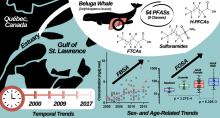| Title | Simultaneous determination of (N-ethyl perfluorooctanesulfonamido ethanol)-based phosphate diester and triester and their biotransformation to perfluorooctanesulfonate in freshwater sediments. |
| Publication Type | Journal Article |
| Year of Publication | 2018 |
| Authors | Zhang, S, Peng, H, Mu, D, Zhao, H, Hu, J |
| Journal | Environ Pollut |
| Volume | 234 |
| Pagination | 821-829 |
| Date Published | 2018 Mar |
| ISSN | 1873-6424 |
| Keywords | Alkanesulfonic Acids, Bacteria, Biodegradation, Environmental, Biotransformation, China, Environmental Monitoring, Fluorocarbons, Geologic Sediments, Hydrocarbons, Fluorinated, Lakes, Organophosphates, Sulfonamides, Tandem Mass Spectrometry, Water Pollutants, Chemical |
| Abstract | While (N-ethyl perfluorooctanesulfonamido ethanol)-based phosphates (SAmPAPs) have been proposed as a group of perfluorooctanesulfonate (PFOS) precursors, investigation of their occurrence and fate has been limited to SAmPAP diester. In this study, SAmPAP diester and triester were simultaneously determined in freshwater sediment from Taihu Lake using a newly developed UPLC-MS/MS method, and their biotransformation to PFOS in lake sediment was investigated. SAmPAP diester and triester were detected in sediments with a detection frequency of 56% and 88%, and their mean concentrations were 0.24 ± 0.11 ng/g dry weight (dw) and 0.12 ± 0.03 ng/g dw, respectively. The SAmPAP diester/triester ratio in sediment was 1.1 ± 4.2, much lower than that (6.7) observed in the technical product, and the positive correlation was found between the concentrations of SAmPAP diester and PFOS in sediments (r = 0.45, p = 0.01), suggesting that SAmPAP diester would be biotransformed to PFOS in the lake sediment. The microbial degradation test in the lake sediments further clarified that SAmPAP diester was biodegraded to PFOS, but SAmPAP triester was highly recalcitrant to microbial degradation. This study suggests that the occurrence of SAmPAP diester in freshwater lake sediments may be an important precursor of PFOS. |
| DOI | 10.1016/j.envpol.2017.12.021 |
| Alternate Journal | Environ. Pollut. |
| PubMed ID | 29247945 |
Environmental Chemical Biology

